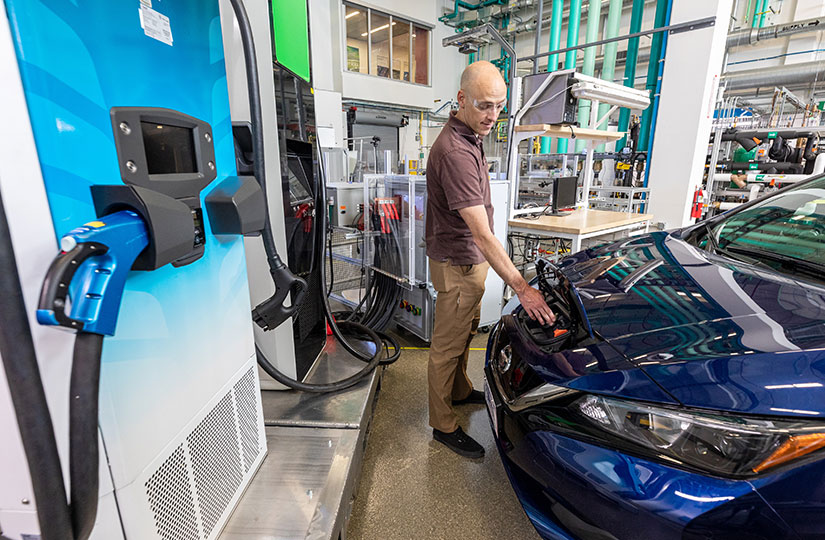NREL Partners With Industry Leaders To Prove Out Grid Integration Solutions
Laboratory Experiments Will Validate Solutions for Safely Scaling the Number of Electric Vehicles on the Grid

The U.S. Department of Energy (DOE) has selected two new projects to benefit from a premier grid control evaluation capability at the National Renewable Energy Laboratory (NREL). One project comes from Dominion Energy using technology from Generac Grid Solutions, and the second is Colorado Springs Utilities leveraging software from Smarter Grid Solution, a wholly owned subsidiary of Mitsubishi Electric Power Products Inc.
Both teams will demonstrate ways distribution utilities can adapt as more of their customers drive and charge electric vehicles (EVs), adding load to the grid. The demonstrations will use NREL’s Advanced Distribution Management System (ADMS) Test Bed, a safe environment to de-risk and build confidence in interconnecting new technologies to the power system. Partners experiment with plug-and-play options in the lab before deployment in the field.
“NREL helps our utility partners answer targeted questions about control architectures and their scalability,” said chief engineer Annabelle Pratt. “I am very excited to work on these EV use cases, since Dominion Energy and Colorado Springs Utilities proposed compelling questions about the future electrical grid that we are primed to answer with the ADMS Test Bed.”
Here is how it works: NREL develops a real-time model of a portion of a utility’s service area including current and projected deployments of distributed energy resources, such as energy storage systems or renewable energy generation. The model couples with real examples of these devices in the laboratory, and engineers evaluate the performance of grid control solutions under simulated scenarios. The ADMS Test Bed was developed by NREL with funding from the DOE Office of Electricity as a vendor-neutral evaluation platform and is a foundational capability for NREL’s Advanced Research on Integrated Energy Systems (ARIES).
Charging Management in Suffolk, Virginia
With some 7 million customers, Dominion Energy is interested in scale. The company is deploying Generac’s Concerto distributed energy resource management system (DERMS) across its service territory in Virginia and North Carolina to support EV owners and electric school buses, as well as customers with solar photovoltaics, battery storage, and other DER technologies.
“NREL’s ADMS Test Bed provides a realistic environment in which to demonstrate the ability of the DERMS to manage EV charging in real time and thereby de-risk our field deployment,” explained Santosh Veda, manager of DERMS at Dominion Energy. The utility also wants to simulate future scenarios to observe DERMS performance as the numbers of EVs and EV aggregators continue to grow. “DERMS deployment is an important part of Dominion’s Grid Transformation Plan for meeting the trend of increased electrification,” Veda said.
The test bed will model a substation service area in the city of Suffolk, Virginia, and an accurate representation of its energy load. NREL experts will help Dominion Energy and Generac evaluate two grid control architectures for EV charging management using the Generac DERMS and multiple EV aggregators.

Energy stored in fully charged EV batteries could offer backup power to a microgrid. Photo by John Gonzales, NREL
Electric Vehicles and Microgrids in Colorado Springs, Colorado
The second partner, Colorado Springs Utilities, is interested in exploring how the electric grid can best accommodate increased demand from electric vehicles and charging stations.
Springs Utilities will partner with NREL to test a section of its grid where a small-scale microgrid is planned for its Mesa Campus, which includes renewable energy sources such as solar, battery energy storage systems, and a public EV charging station. The hope is to determine the impacts additional energy demands, like EV charging stations, have on the microgrid and surrounding community and to test backup plans in case of power disruptions.
To do this, Springs Utilities is teaming up with NREL to use Smarter Grid Solutions’ Strata Grid technology to test different scenarios to help Springs Utilities assess scenarios of high demand on the grid.
Brett Jackson, the microgrid project manager at Springs Utilities, is excited about the collaboration.
“We believe that the insights gained from these simulations will help us better prepare for the future,” Jackson said. “This information will help ensure that we’re making informed decisions about energy resilience in Colorado Springs and how we can best invest customers’ rate dollars in our electric grid.”

Researchers use NREL's state-of-the-art research infrastructure to develop optimal strategies for coordinating EVs with buildings, the grid, and other energy systems. Photo by Werner Slocum, NREL
Learn about NREL’s platform for Advanced Research on Integrated Energy Systems (ARIES) and the laboratory’s sustainable transportation and mobility research, including its focus on electric vehicle grid integration.
Last Updated May 28, 2025
